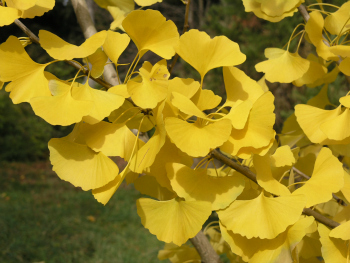10 things I love about gingko trees

Ginkgo trees have fantastic autumn foliage. Photo by Peter Del Tredici
By Carol Ann McCormick
Guest Flora Columnist
1. They’re old – really old. The earliest gingko trees were found in the Middle Jurassic (180 million years ago), and the seeds were probably dispersed by carrion-eating dinosaurs. Since the Jurassic there have been about a dozen species, but only Ginkgo biloba is alive today, and since we are sadly lacking in dinosaurs, it now depends on humans for dispersal.
2. Ginkgo biloba is more closely related to pines than to maples and oaks. (For botany wonks, it is a gymnosperm in its own division, Ginkgophyta.) An individual tree is either male or female, and depends on the wind, not insects, for pollination.
3. An individual tree can live 1,500 years! Ginkgo biloba is native to China and the oldest trees are found growing near temples. Monks did not ascribe any religious significance to the trees, but appreciated them for their longevity, beautiful leaves and edible nuts.

Ginkgo fruit and green leaves. Photo by Laura Cotterman
4. Ginkgo seeds have a squishy outside (“sarcotesta†for those studying for the SAT) containing hexanoic and butanoic acids, so they smell like rotten flesh or vomit (remember the carrion-eating dinosaurs in 1?). However, the interior “nut†is not stinky and is used in Asian cuisine. Margo MacIntyre, curator of the Coker Arboretum, reports that the seeds are avidly harvested by visitors. (She also asks that you not leave a pile of sarcotesta right by the bench where other people want to sit and enjoy the ginkgo foliage.)
5. Ginkgo trees have beautiful leaves – simple and elegant in form, leathery in texture. Ginkgo adiantoides, an extinct species native to North America, had leaves remarkably similar to Ginkgo biloba.

Golden ginkgo. Photo by Peter Del Tredici
7. Despite cultivation for 200-plus years in America, there is scant evidence of gingko naturalizing and becoming a weed.
8. Ginkgo trees have fantastic autumn foliage. In mid-October an entire tree will go from green to gold in a day or two. In mid-November, the tree will go from all gold to bare in just a day or two.
9. The University of New Hampshire has annual contests to Pick the Day the Ginkgo Leaves Fall (winner gets pizza) and Catch a Ginkgo Leaf (winners get good luck for the year). “They’re actually quite difficult to catch,†says UNH student Mary Dellenbaugh. “Because the leaves are fan-shaped, their falling pattern is very erratic. As soon as you think you have it in your hand, it darts out of reach.â€

Ginkgo adiantoides fossil. Photo by Patricia Gensel
10. Go find a ginkgo! There are two mature trees (one male, one female) along the north edge of the lawn in Coker Arboretum on the UNC campus. Between Hanes Art Center and Kenan Music Hall there is a new allé of 20 trees, and UNC Forester Tom Bythell promises, “In a decade when these trees are mature, this will be the place to be when the leaves turn gold.â€
Email Ken Moore at flora@carrborocitizen.com. Find previous Ken Moore Citizen columns at The Annotated Flora.


Comments are closed.